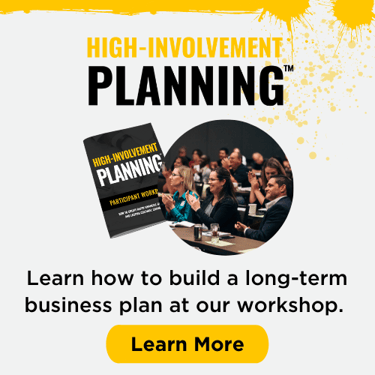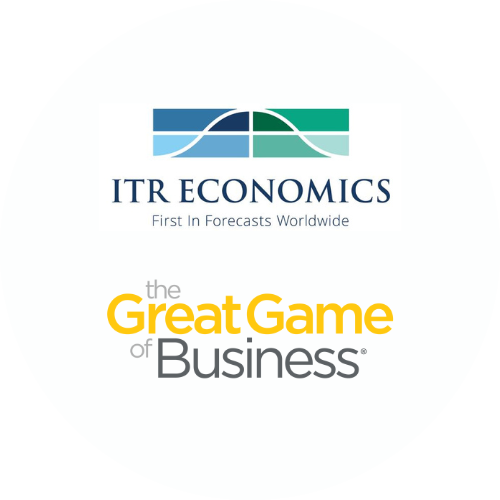.png?width=790&name=If%20you%20want%20to%20forecast%20the%20future%2c%20youre%20going%20to%20need%20accurate%20data%20(1).png)
Paint an objective picture of your business by bringing the marketplace to your people
One of the overlooked strengths of any company is its ability to look ahead. It’s not enough to see how it’s performing now or even what it has accomplished in the past. You need to constantly look to the future.
Learn More About Using Marketplace Data In Your Business Plan at our Workshop
Planning for the future—which is really just figuring out where you want to go from here—is something an organization like The Great Game of Business does all the time. For example, the team forecasts its monthly sales, profit, and cash projections on a weekly basis, which they adjust, learn from, and improve over time.
They also get together twice a year with their nine sister companies in the SRC family as part of their High-involvement Planning (HIP) process to look further out. In June, they share updates on where they are relative to their plans for the year—and what their forecasts look like going forward. In October, they reconvene and share their plans for the following year—and for the next five years out.
Of course, there are plenty of critics who say that you simply can’t plan that far out. Things change far too fast, they say.
But if you aren’t planning ahead, how do you know where you’re going? It’s like trying to drive a car down the interstate looking through your rear-view mirror instead of the windshield.
There’s another important lesson to keep in mind. If you do want to forecast what the future holds for your organization, you need to have accurate data to base your plans on.
Painting An Accurate Picture

At the root of HIP is trying to paint as accurate a picture of the economy and where it’s headed as you can. If you can accurately assess the macroeconomic trends driving the economy, you can learn a lot about the future trends driving supply and demand. You can then dig deeper, breaking down that data into the microeconomic snapshot of the markets you operate in so you can better understand what economic pressures your customers might be facing.
To paint this economic big picture, you need to have an appetite—a hunger—for data. You need to be reading the papers and watching the news every day in a hunt for clues to where things are heading. One simple measure you might look at daily, for example, is the price of copper—which continues to be a real bellwether for the direction of the economy.
You also don’t have to do all the heavy lifting by yourself. You can also leverage partners such as ITR Economics for help in building your business strategy using their accurate sales and vertical market forecast programs. For decades, the Great Game and their sister SRC companies have relied on the highly accurate forecasts ITR provides to help guide their own planning process. Case in point: ITR’s overall forecast accuracy one year out has been 94.7% accurate since 1985, including through all the uncertainty of the pandemic years.
“Consistently, our clients tell us that they find using our sales and/or industry forecasts removes the emotions and stress out of building strategy,” says Kimberly Clark, VP of Sales and Marketing at ITR Economics. “This allows business leaders to go beyond intuition and build a strategy around real facts.”
The key, Clark says, is that whatever information you’re using in your planning processes needs to be reliable. “If your data isn’t accurate or consistently reliable, it can introduce potential errors into your plan,” she says. “Knowing that our firm has such a reliable track record that is published annually gives our clients the confidence they need to act on the guidance provided by our trusted advisors.”
Creating Strategy Based On Facts More Than Intuition
The accuracy of ITR’s forecasts continues to humble Clark—who does her own “bottoms up” forecasts based on her own analysis of her client data, such as what she expects from her client retention rate and how much new business she expects the firm to win. Yet, when she compares how her forecast fared to ITR’s proprietary forecasts every year, she is always impressed with how close the two version are, and how the ITR-approach forecast is closer to the actuals at the end of the year. “They are able to get a more accurate picture because they are using ITR Economics’ proprietary forecasting process that incorporates so much more than what I could possibly account for in my own process,” she says.
That’s different from some of the business owners that Clark speaks with who still set their strategy based on their intuition or gut feel—rather than a fact-based forecast.
“I understand why some business leaders still plan using intuition because I consider myself to be an intuitive person as well,” she says. “But over the years, the results don’t lie, and I’ve learned to trust the forecast.”
Setting pricing for the coming year is a strategic area that Clark recommends clients look to ITR industry reports for help. For example, she says their clients look at how inflation is forecasted to impact certain industries for help in deciding if they should pass along a price hike for a certain service or not. “If you know that a client’s business might do well over a period of time then they might be a group who could withstand a price increase,” she says. “On the other hand, if their industry is expected to decline, you most likely wouldn’t want to push through an increase.”
She also recommends business leaders conduct an analysis of what the competition is doing in the marketplace—how they are setting their prices or how they are positioning their marketing—to help direct your sales and marketing strategies.
“One of the big push backs we hear all the time is that people feel like they don’t have the time to plan,” says Clark. “We are all so busy; you’ll never find the time. You must make the time. In the end, it will make the difference between being reactive vs. gaining the benefits of being proactive.”
Bringing The Marketplace To Your People
This is such a great example of how you can use data to bring the marketplace to your people. Rather than thinking that the CEO or the sales team is setting the standards when it comes to pricing or whether you can afford to give out a raise, you can use the forecast and what the competition is doing to explain what’s possible. It’s not based on a whim of leadership or a flip of the coin—it’s about staring reality in the face.
As Jack Stack, the CEO of SRC, likes to say: “If you control a forecast, you control the world.”
Learn more about business planning at our workshop. Get the help you need to build a business plan you and your team feel confident about!
.png)








.png)




-5.png)

